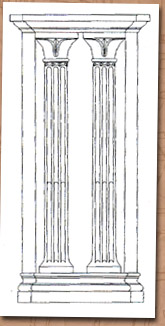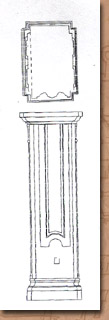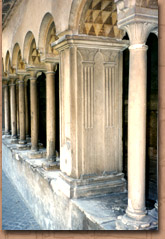The pilasters
edited by Mara Falconi
There are ten marble pilasters that alternate with the coupled columns of the internal enclosure of the cloister: four are positioned at the corners, two couples mark the passage towards the center on the east and west sides and the final two divide the center line of the north and south side. The corner pilasters have an L-shaped plan while the others have a cruciform plan and, on all of them, the sides facing on to the coupled columns are decorated by a pair of pilaster strips similarly coupled and fluted.
The pairs of pilaster strips have a different decoration according to the pilaster: some have a smooth capital and have been simply carved, others have a flat-leaf floral motif on the capitals that re-echoes the one on the columns and, in the upper part of the fluting on the shaft, where it is linked up in a semicircle, there is a motif with small leaves that sprout from this joint.This latter type of decoration is the most frequent and the only pilasters without it are the ones in the central passage of the east corridor (fig. 1). The central pilaster of the south corridor is the only one whose north side, the one that is facing the center of the cloister, is decorated; this peculiarity is due to the fact that the pilaster represents recovered material (fig. 2-3).
All the pilasters are made up of individual elements, namely the base, shaft and cornice which, in their turn, can be monolithic or composed of several parts or consist of recovered stone material, sometimes bearing inscriptions, which have been worked and affixed to each other. This is the case with all the corner pilasters like, for example, the south-west one where it is evident how individual slabs, varying in thickness from 5 to 7 cm., have been assembled to create the shaft, whereas both the cornice and the base are made up of various marble blocks that have been worked and joined together.The workmanship is of good quality, the dimensions of the individual mouldings correspond in all the pilasters, as does the total height of about 130 cm. and the height of both the upper cornices and the bases that varies between 8 - 8.5 cm. and 14 -14.5 cm. respectively. What appears instead to be approximate is the assembly of the individual parts, which do not often appear to be on the same axis. It remains to be seen whether this lack of axiality is due to imperfect assembly or to subsidence occurring over time, bearing in mind that all the pilasters are considerably off-center which may have caused a reciprocal movement of the individual elements.
All the pilasters seem to be original and were neither replaced nor modified during the restoration by Muñoz who, instead, made only two inserts to reintegrate the losses. These inserts are located on the south side of the central pilaster of the south corridor and on the south side of the pilaster in the north-west corner. Traces of color tending to red can be observed on the east side of the pilaster of the south-west corner.Subsequent analysis will be able to determine whether this coloring was also present on all the other pilasters and, above all, if it used to be the tone coloring all the elements making up the cloister. The pilasters of the south side and the two central couples of the east and west sides are those that have sustained greater damage due to an extensive black crust that has badly deteriorated the surface and made it particularly fragile to even minimal mechanical stresses.
|
©
1999 Coordination Monica Morbidelli |
|
Fig. 1 - West corridor, north pilaster, north elevation.
Fig. 2 - South corridor, central pilaster, plan and north elevation.
Fig. 3 - South corridor, detail of central pilaster.
|
|
|
|
|
|
|


